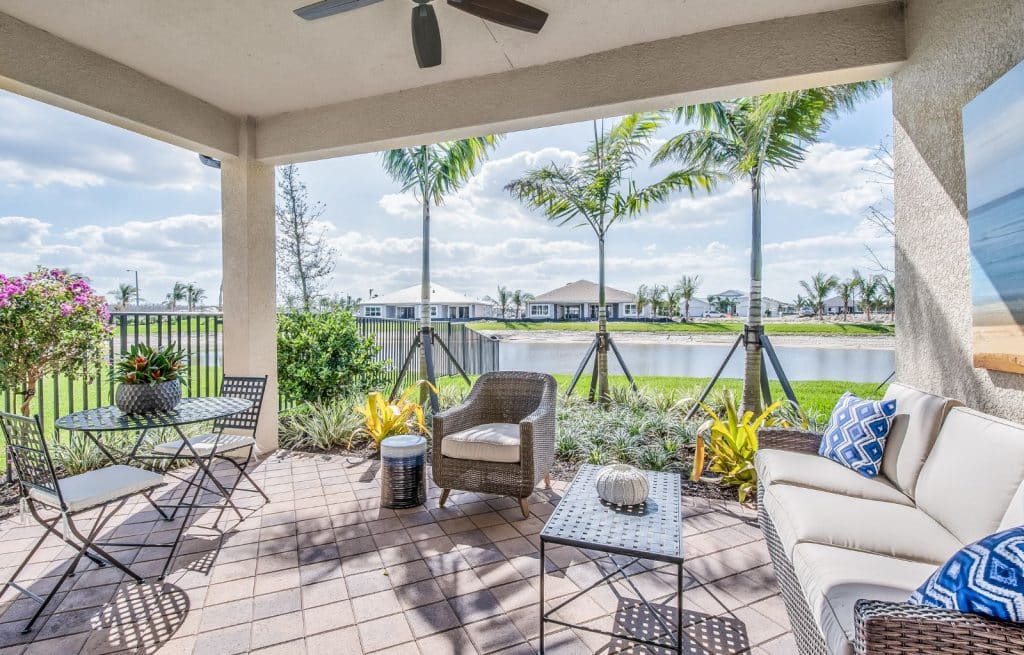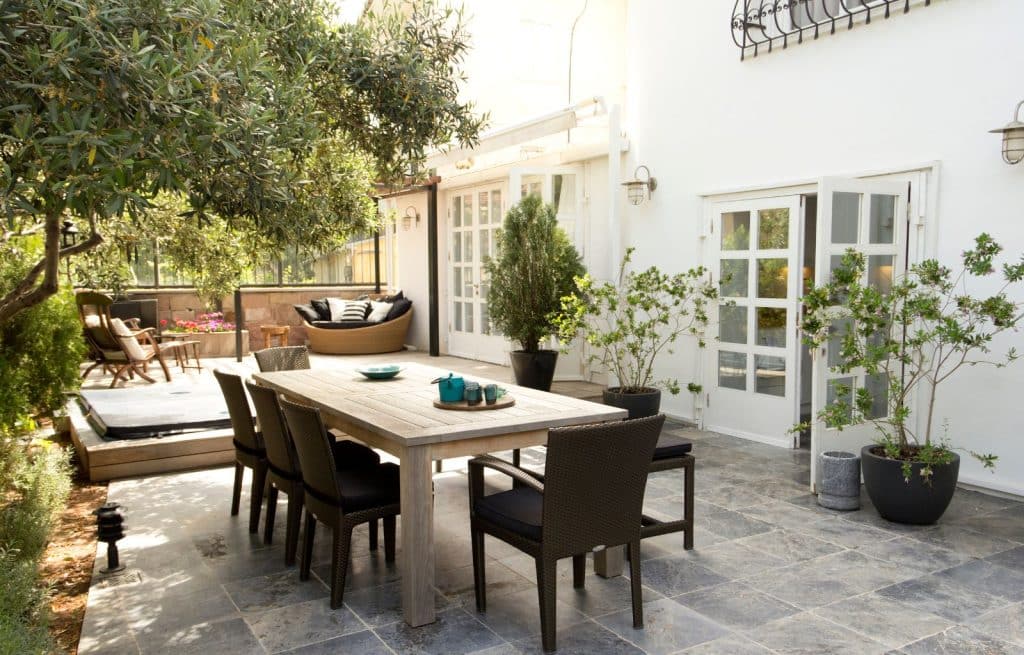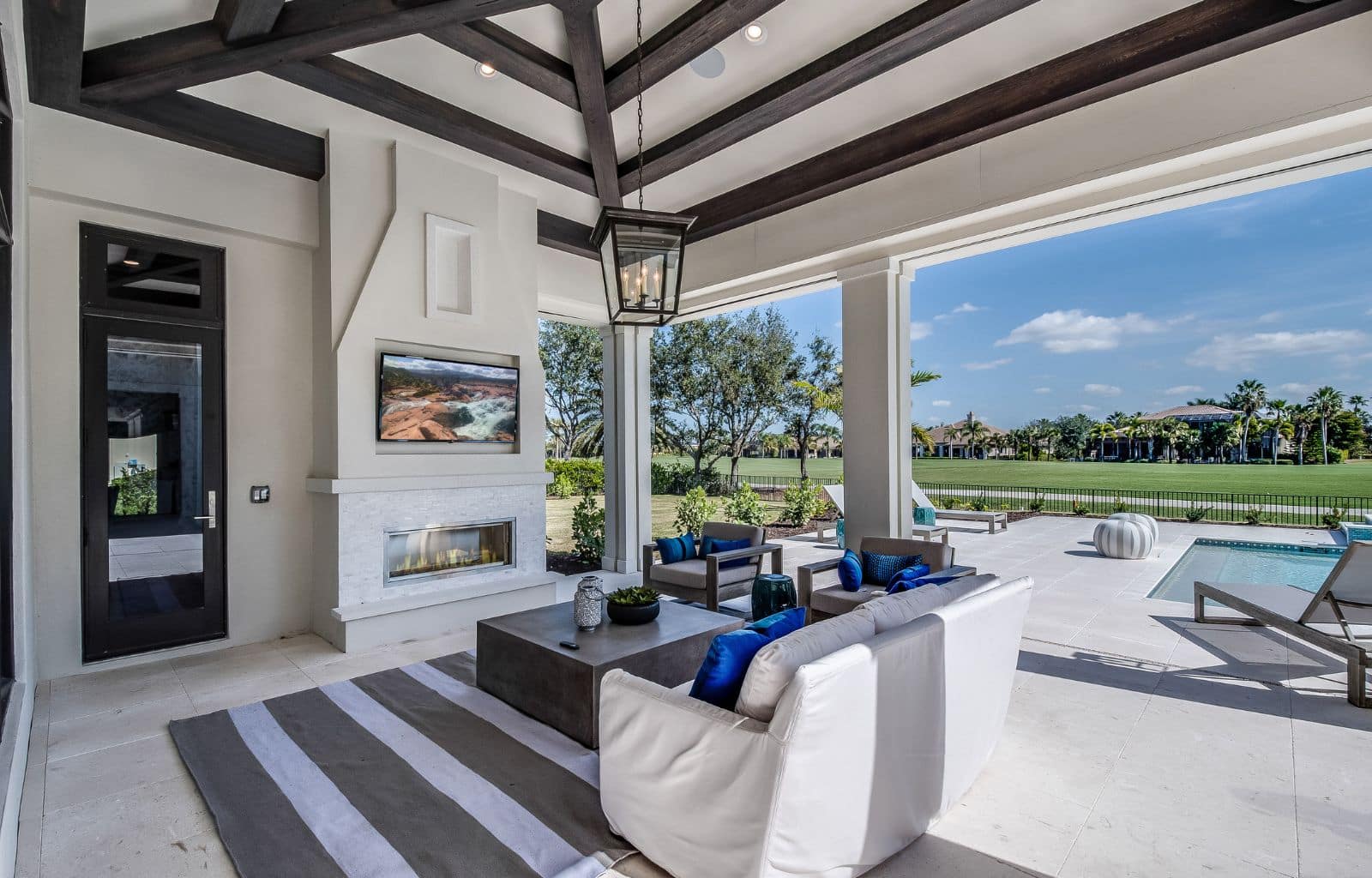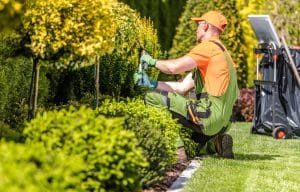If there’s one thing San Diegans know how to do well, it’s living outdoors. Our enviable Mediterranean climate provides over 260 days of sunshine each year and temperatures that hover in the perfect sweet spot, so our outdoor spaces have become much more than just yards or patios—they’re true extensions of our homes.
Imagine starting your day with coffee on your perfectly designed patio, where the morning light filters through strategically placed trees. Later, you might work remotely from your outdoor office nook, surrounded by the gentle sounds of a water feature. As evening approaches, your space transforms into an entertainment hub where friends gather around the fire pit, enjoying the famous San Diego sunset.
This shift toward outdoor living isn’t just about enjoying good weather – it’s about maximizing every square foot of our properties and creating versatile spaces that serve multiple purposes throughout the day. From cozy reading corners to full outdoor kitchens, San Diegans are reimagining what it means to “go outside.”
In this comprehensive guide, we’ll explain everything you need to know about creating your own outdoor paradise. Whether working with a modest patio or planning a complete backyard transformation, you’ll discover practical tips, design principles, and professional insights to help you maximize your outdoor space in our unique San Diego climate.
Design Principles

Creating a successful outdoor living space is like solving a beautiful puzzle – it’s all about fitting together the right pieces in a way that makes sense for your lifestyle. Let’s explore the core principles that will guide your design decisions.
Functionality First
The most beautiful outdoor space in the world won’t bring you joy if it doesn’t work for your daily life. Before you get caught up in choosing tiles or picking out plants, ask yourself some essential questions: How do you want to use this space? Do you need areas for dining, cooking, or entertaining? Are you dreaming of a peaceful meditation garden or need a kid-friendly zone for active play?
Think about your daily routines and special occasions. Maybe you work from home and could use a sheltered outdoor workspace for those perfect San Diego afternoons. Perhaps you host regular family gatherings and need plenty of seating and dining space. Your answers to these questions will form the foundation of your design.
Adaptability: The Key to Longevity
Innovative outdoor spaces in San Diego can transform throughout the day and across seasons. That morning yoga spot might become an afternoon homework station for the kids and then an evening entertainment area. The key is creating flexible zones that can serve multiple purposes.
Consider furniture that can be easily moved or reconfigured, and consider including features like removable shade sails or portable heaters that help you adapt to changing weather conditions—even in our mild climate, a little adaptation goes a long way.
Creating “Outdoor Rooms”
One of the most effective design strategies is to think of your outdoor space as a series of rooms, just like inside your house. But instead of walls, you’ll use subtle design elements to define different areas. This concept, “implied spaces,” creates flow and organization without feeling boxed in.
You might use changes in flooring materials – transitioning from decking to pavers, for instance – to suggest different zones. Strategic placement of plants can create natural dividers while varying heights in your hardscape can define distinct areas. For example, a slight level change of just a few inches can elegantly separate a dining area from a lounge space.
The magic happens when these zones flow naturally into each other while maintaining their distinct character. Like a well-designed open floor plan inside your home, your outdoor spaces should feel connected and purposeful.
Designing for Small Spaces

Don’t let limited square footage dampen your outdoor living dreams. Some of San Diego’s most charming and functional outdoor spaces come in smaller packages. The key is maximizing every inch while maintaining a sense of openness and flow.
Making the Most of Built-In Features
Built-in elements are your secret weapon in small-space design. A well-planned built-in bench can provide ample seating without the bulk of traditional patio furniture, while its base might conceal storage for cushions, gardening tools, or kids’ toys. Consider wrapping these benches around corners or following the natural contours of your space—this not only maximizes seating but also creates a custom, high-end look.
Think vertically, too. Built-in planters can double as privacy screens, and wall-mounted features like fountain fixtures or hanging gardens add interest without consuming precious floor space. With the right design approach, even a narrow side yard can become a stunning vertical garden.
The Power of Permanent Over Portable
Too much movable furniture can quickly create visual clutter and make a compact space feel cramped. Instead, prioritize fixed elements that serve multiple purposes. A built-in counter might function as a serving station during parties, a potting bench for your container garden, and a casual dining spot for everyday use.
Consider elements like a permanent gas fire pit that becomes a focal point without requiring the storage space that a portable one would need. Permanent lighting fixtures, rather than multiple portable lanterns, keep the space feeling clean and intentional while providing essential illumination.
Creating Intimate Areas
Small spaces have a natural advantage when creating cozy, intimate areas. Work with this inherent coziness rather than fighting against it. Overhead elements like pergolas or sail shades can create a sense of enclosure, making a space feel defined without using valuable square footage.
Layer your design with different heights and textures to create visual interest within a limited area. A small water feature can mask urban noise while adding a focal point. Strategic plant choices – think upright grasses or columnar trees – can provide privacy and greenery without overwhelming the space.
One clever trick is to create “rooms within rooms” using changes in materials or subtle level changes. Even in a 10×10 patio, you might carve out distinct areas for dining and lounging through thoughtful design choices. The key is maintaining clear sight lines throughout the space while defining separate functional zones.
Remember that every element needs to earn its keep in a small space. Choose multi-functional pieces and be selective about decorative elements. A stunning piece of garden art might have more impact than multiple miniature decorations that could make the space feel cluttered.
Working With Your Site

Understanding and embracing your property’s natural characteristics isn’t just good design – it’s smart economics and environmental stewardship. Every San Diego property tells its own story through its terrain, exposure, and existing features. Learning to read and work with these elements can distinguish between a struggling landscape and a thriving outdoor living space.
Assessing Your Site’s Natural Features
Start by spending time observing your space at different times of day. Where does the sun fall throughout the day? Which areas get the strongest afternoon winds? Are there existing views you want to preserve or unsightly elements you need to screen? Notice how water moves across your property during our occasional rainstorms.
Pay attention to your soil type too. San Diego’s soils can vary dramatically, from sandy coastal compositions to dense clay inland. These differences will affect everything from drainage to plant selection. If you’re unsure about your soil type, consider getting a professional soil test – a small investment that can prevent costly mistakes.
Natural terrain features that might initially seem like challenges can become unique opportunities:
- A sloped yard could become a dramatic terraced garden with built-in seating
- A low spot might be perfect for a rain garden or water feature
- Areas with poor soil might be ideal for raised beds or hardscaped entertaining spaces
Working With, Not Against, Your Land
Fighting your site’s natural characteristics usually leads to three problems: high initial costs, ongoing maintenance headaches, and potential environmental issues. For example, significantly regrading a sloped yard doesn’t just come with a hefty price tag – it can also create drainage problems and require expensive retaining walls.
Instead, let your site’s natural contours guide your design choices. If you have a slope, consider creating different outdoor “rooms” at various levels, connected by pathways or steps. This approach often results in more exciting and usable spaces than a single flat area would provide.
Letting the Landscape Lead
Existing trees and other natural features can become focal points in your design. A mature tree, for instance, provides instant shade and character that would take decades to recreate. Before removing any existing vegetation, consider whether it might be incorporated into your new design.
Even challenging features can be turned into assets:
- Rocky areas can become dramatic boulder gardens
- Dry, sunny spots are perfect for water-wise Mediterranean plants
- Shady areas under trees can host shade-loving plants or seating areas
Remember that your outdoor space exists within a larger ecosystem. Working with your site’s natural characteristics often results in a more sustainable landscape that requires less water, fewer inputs, and less maintenance over time.
Design Considerations

Creating a stunning outdoor living space is all about balancing aesthetics with practicality. Let’s explore the key design elements that will make your space beautiful and functional in San Diego’s unique climate.
The Power of Contrast
Just as an artist uses different elements to create visual interest in a painting, your outdoor space needs variety to come alive. Think about contrast in terms of:
Textures: Pair smooth surfaces with rough ones – perhaps sleek concrete seating next to a textured stone wall. Mix soft, billowing grasses with structured succulents. These contrasts create visual and tactile interest that draws people into the space.
Materials: Combine different materials thoughtfully. A wooden deck might transition to concrete pavers, then to gravel or decomposed granite. Each material change can define a new area while adding visual appeal. Just remember to limit your material palette to avoid a cluttered look—three to four main materials are usually enough.
Colors: San Diego’s bright sunlight makes colors appear more intense. Use this to your advantage by creating deliberate color contrasts, but keep them controlled. A background of neutral hardscaping materials punctuated by carefully chosen bright plants often works better than a riot of colors.
Smart Plant Selection
Plants are more than just decoration – they’re living elements that can make or break your outdoor space. In San Diego, native and Mediterranean plants offer several advantages:
- They’re adapted to our climate and rainfall patterns
- They attract local wildlife, including beneficial insects and birds
- They typically require less maintenance and water once established
- They connect your space to the larger Southern California landscape
Popular native choices include:
- Coast Live Oak for shade and grandeur
- California Lilac for spring color
- Manzanita for year-round structure
- Native sages for fragrance and pollinators
Planning for Growth
One of the biggest mistakes in landscape design is not accounting for how plants will grow over time. That cute one-gallon plant might become an eight-foot giant in a few years. Consider:
Mature Size: Research each plant’s full-grown size and space them accordingly. It’s better to have gaps you can fill with temporary plants than to crowd permanent specimens.
Growth Rate: Fast-growing plants might give you quick privacy but could require more maintenance. Slower-growing species might take longer to establish but often need less pruning.
Root Systems: Some plants have aggressive roots that can damage hardscaping or utilities. Know what’s happening below ground before you plant.
Creating and Maintaining Sight Lines
Good sight lines make a space feel larger and more inviting while guiding movement through the garden. Consider:
Views: Frame desirable views and screen unsightly ones. This might mean creating “windows” through plantings or using taller elements to block unwanted views.
Movement: Create clear paths through the space that feel natural and intuitive. Sight lines should draw people through the garden, revealing new views and destinations.
Safety: Maintain clear views of entries and exits and ensure outdoor lighting illuminates pathways and transitions between spaces.
Scale: Keep plants and structures proportionate to your space and your home. With proper scaling and clear sight lines, even small areas can feel spacious.
Common Design Mistakes to Avoid

Even with the best intentions, it’s easy to fall into common design traps. Let’s explore these pitfalls and learn how to avoid them, saving you time, money, and frustration in your outdoor living project.
Space Planning Errors
One of the most frequent mistakes is overcrowding your space. Remember these key measurements:
- Allow at least 3 feet for walkways, 4 feet for primary paths
- Leave 24-30 inches between seating and tables
- Keep 6-8 feet clear around dining areas for chairs and movement
- Maintain at least 3 feet of clearance around grills or outdoor kitchens
Think about flow and function. That beautiful outdoor sofa might look perfect in the catalog, but if it blocks the natural path from your kitchen to the dining area, it will become a daily frustration.
The Lawn Dilemma
While a patch of grass can be nice, many San Diego homeowners make the mistake of including too much lawn in their design. Large lawns:
- Consume excessive water in our arid climate
- Require regular maintenance and chemical inputs
- Often, they go unused except as pathways
- Miss opportunities for more exciting and functional spaces
Instead, consider limiting lawns to areas where you’ll use it for recreation or relaxation. Replace unnecessary turf with:
- Native plant gardens that support local wildlife
- Permeable hardscaping for entertaining areas
- Drought-tolerant groundcovers
- Practical spaces like vegetable gardens or outdoor living areas
The DIY Trap
While some projects can be DIY successes, tackling complex design challenges without professional help often leads to costly mistakes. A professional landscape designer brings:
- Technical knowledge about grading, drainage, and construction
- Understanding of local building codes and permits
- Experience with plant selection and placement
- Access to quality materials and contractors
- Ability to create cohesive, functional designs
Investment in professional design often pays off by avoiding expensive mistakes and creating more usable, sustainable spaces.
Contractor Selection Missteps
Choosing the wrong contractor can turn your dream project into a nightmare. Common mistakes include:
- Selecting based solely on price without checking credentials
- Not verifying licenses and insurance
- Skipping reference checks and site visits to previous projects
- Failing to get detailed, written proposals
- Not checking reviews and ratings from past clients
Take time to vet potential contractors thoroughly. Ask for detailed portfolios, meet their team, and don’t be afraid to ask tough questions about their experience and process.
Color and Material Mistakes
Overcomplicating your color palette can make your space feel busy and uncoordinated. Instead:
- Choose a central color theme with 2-3 primary colors
- Use additional colors as accents only
- Consider how colors will look in bright sunlight
- Think about a year-round appeal, not just a seasonal impact
With materials, avoid:
- Mixing too many different types (stick to 3-4 primary materials)
- Choosing based on initial cost without considering longevity
- Selecting materials that don’t complement your home’s architecture
- Using materials that aren’t appropriate for our climate
Cutting Corners on Quality
While saving money on materials is tempting, choosing lower-quality options often costs more in the long run. Invest in:
- Commercial-grade outdoor furniture that will last
- High-quality pavers or decking materials
- Professional-grade irrigation components
- Properly sized and installed electrical and plumbing
- Quality outdoor lighting fixtures
Remember: The cost of replacing cheap materials often exceeds the initial savings, not to mention the inconvenience of frequent repairs and replacements.
Popular Outdoor Living Features

Let’s explore the most sought-after outdoor living features in San Diego homes and provide practical advice for incorporating them into your space.
Adding Warmth and Ambiance Fire pits and fireplaces have become must-have elements in San Diego outdoor spaces, and for good reason:
Built-in Fire Pits:
- Create natural gathering spots for evening entertainment
- Provide warmth during cooler coastal evenings
- Can range from simple gas rings to elaborate stone features
- Typically require 15-20 feet of clear space for safety and comfort
- Cost range: $2,500-$15,000+ depending on design and materials
Outdoor Fireplaces:
- Offer more architectural presence
- Can provide privacy and wind protection
- Create a strong focal point
- It may require permits and professional installation
- Cost range: $8,000-$25,000+
Lighting: Extending Your Outdoor Hours Good lighting transforms your outdoor space from day to night:
Essential Lighting Layers:
- Path lighting for safety and navigation
- Task lighting for cooking and dining areas
- Accent lighting to highlight landscape features
- Ambient lighting for the overall atmosphere
Smart Features:
- LED fixtures for energy efficiency
- Automated controls for convenience
- Zoned lighting for different activities
- Dark-sky compliant fixtures to reduce light pollution
- Cost range: $3,000-$12,000 for a comprehensive system
Covered Patios: Creating Outdoor Rooms These structures extend your living space and provide year-round usability:
Popular Options:
- Solid roof extensions
- Pergolas with adjustable louvers
- Retractable awnings
- Shade sails
Key Considerations:
- Match the architectural style of your home
- Consider sun angles throughout the year
- Include proper drainage and lighting
- Add fans for air circulation
- Cost range: $5,000-$30,000+, depending on size and style
Plunge Pools: Compact Cooling Perfect for smaller San Diego lots, plunge pools offer:
- Cooling relief in compact spaces (typically 10’x12′ to 8’x16′)
- Lower maintenance costs than full-size pools
- Ability to add features like jets or heating
- Optional swim-in-place systems
- Cost range: $15,000-$45,000+
Social Front Yards: Building Community A growing trend in San Diego neighborhoods:
- Creates welcoming spaces for neighbor interaction
- Includes seating areas and gathering spaces
- Maintains privacy while encouraging connection
- Often features drought-tolerant landscaping
- Cost range: $10,000-$25,000 for complete transformation
Outdoor Kitchens: Elevating Entertainment From simple to elaborate, outdoor kitchens might include:
Basic Setup:
- Built-in grill
- Counter space
- Storage
- Small refrigerator
- Cost range: $5,000-$15,000
Deluxe Features:
- Pizza ovens
- Side burners
- Bar areas
- Ice makers
- Dining space
- Cost range: $15,000-$50,000+
Design Considerations:
- Proper ventilation for cooking areas
- Durable, weather-resistant materials
- Adequate lighting for evening cooking
- Easy access to the indoor kitchen
- Storage for supplies and equipment
- Protection from prevailing winds
Finding the Right Team for Your Outdoor Living Project

The success of your outdoor living space often depends on the professionals you choose to bring your vision to life. Finding the right team in San Diego’s competitive landscape market requires careful consideration and research.
Understanding Professional Roles
Different outdoor projects require different types of professionals. Landscape architects excel at complex projects requiring extensive hardscaping, grading, or technical expertise. They’re particularly valuable when your project involves significant engineering challenges or requires detailed permits. On the other hand, landscape designers often specialize in plant-focused designs and smaller-scale renovations, bringing artistic vision and horticultural expertise to your project.
The Design-Build Advantage
Many San Diego homeowners are discovering the benefits of working with design-build firms. These companies offer a comprehensive service that takes your project from concept to completion under one roof. This integrated approach typically provides better coordination, clearer communication, and more accurate budgeting than working with separate design and construction teams.
When evaluating design-build firms, look for companies with an established local presence, a strong portfolio of completed projects similar to your vision, and licensed contractors on staff. Their familiarity with San Diego’s unique climate, building codes, and permit requirements can prove invaluable throughout your project.
Making the Most of Consultations
The initial consultation with potential professionals is your opportunity to assess their expertise and communication style. Before the meeting, gather inspiration photos and consider your must-have features. Having a rough budget in mind helps guide the conversation toward realistic solutions.
During consultations, pay attention to how well the professional listens to your ideas and concerns. The best designers will ask thoughtful questions about your lifestyle, maintenance preferences, and how you plan to use the space. They should be able to clearly explain their design process and how they handle challenges that arise during construction.
Understanding Proposals and Bids
A professional proposal should tell the complete story of your project. Look for detailed scope descriptions, specific materials and products to be used, and clear timeline expectations. The payment schedule should be reasonable, with deposits typically not exceeding 10% of the total project cost. Be wary of vague proposals or unusually low bids—they often lead to complications and additional costs during construction.
Project Management Essentials
Once you’ve selected your team, establishing clear communication protocols is crucial. Work with your project manager to set regular meeting schedules and determine the best ways to stay informed about progress. Every significant decision should be documented in writing, and there should be a clear process for handling any changes that arise during construction.
Quality professionals will provide regular updates on both timeline and budget, documenting progress through photos and written reports. They should also have an established system for addressing concerns and completing final punch list items before project completion.
Working with References
Be sure to complete the crucial step of checking references. Speaking with previous clients can provide valuable insights into how a company handles challenges, maintains communication, and follows through on its commitments. Ask about the company’s attention to detail, adherence to timelines, and post-project support.
Creating Your Legacy: A San Diego Outdoor Living Investment

In San Diego’s luxury real estate market, a thoughtfully designed outdoor living space is more than an amenity – it’s a crucial component of your property’s value proposition. As we’ve explored throughout this guide, transforming your outdoor space requires careful planning, expert execution, and attention to aesthetic and practical details.
The Premium Investment
Well-designed outdoor spaces consistently prove to be wise investments in San Diego’s high-end market, often returning 80% or more of their cost in immediate home value. More importantly, they create a distinctive living experience that separates luxury properties. From private meditation gardens to elaborate entertainment spaces, these outdoor sanctuaries become signature features that enhance daily life and property marketability.
Beyond the Bottom Line
For San Diego’s discerning homeowners, the value of a masterfully designed outdoor space extends far beyond financial returns. These spaces become natural extensions of your home’s luxury amenities, offering private retreats for relaxation and sophisticated venues for entertainment. In our increasingly digital world, having a personal sanctuary that seamlessly blends indoor and outdoor living has become a hallmark of premium properties.
Sustainable Luxury
Today’s luxury outdoor spaces embrace sustainable design without compromising elegance. By incorporating smart irrigation systems, native landscaping, and eco-friendly materials, your outdoor living space can exemplify responsible stewardship while maintaining the highest standards of luxury and comfort.
Your Next Step
Creating an exceptional outdoor living space requires more than just a vision – it demands expertise in design, construction, and San Diego’s unique market dynamics. At Scottway, we understand that your outdoor space is integral to your property’s value and lifestyle aspirations.
Ready to Transform Your Outdoor Space?

Scottway’s integrated luxury real estate and construction approach offers a seamless path to realizing your outdoor living dreams. Our team can guide you through every phase, from initial design concepts to final construction details, ensuring your outdoor space meets the highest standards of luxury and functionality.
Contact us to schedule a private consultation:
- For property acquisition and investment strategies: Call Scottway Capital at (619) 209-3544
- For custom construction and renovation: Reach Scottway Construction at (858) 905-2060
Visit our office at 7220 Trade St #136, San Diego, CA 92121 to discuss how we can help you create an outdoor living space that enhances your property’s value and lifestyle.
Your perfect outdoor sanctuary awaits. Let Scottway’s luxury real estate and construction expertise bring your vision to life.





